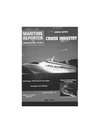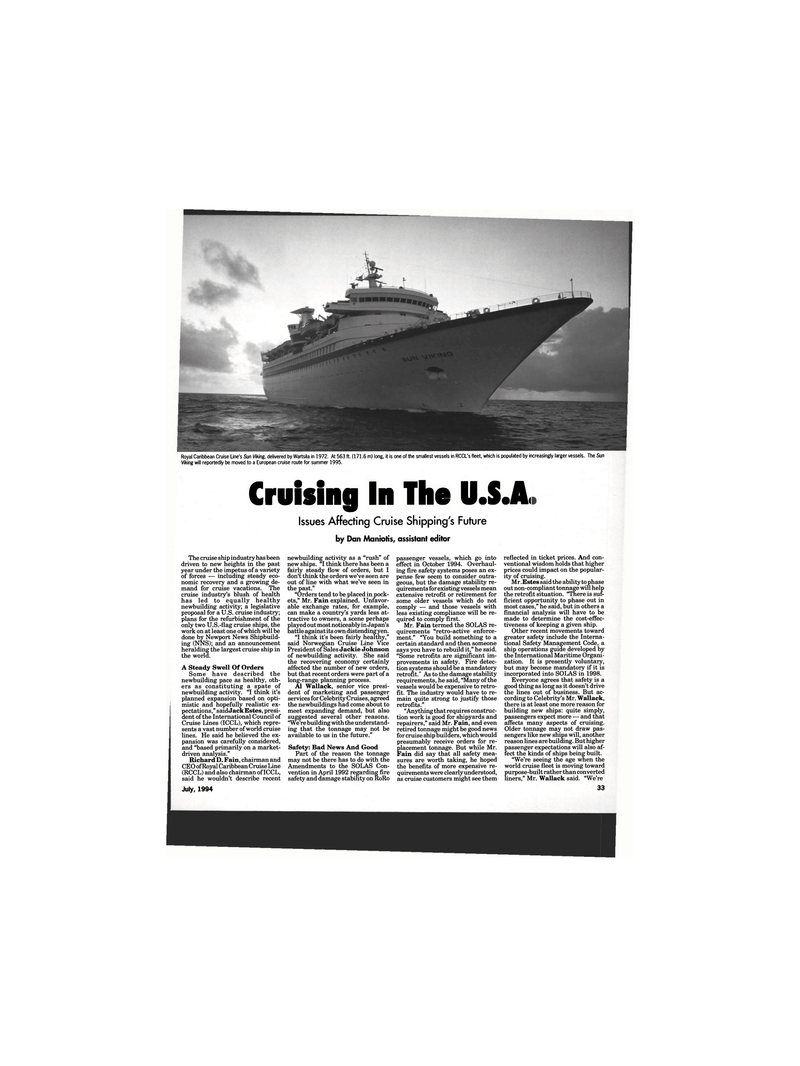
Page 31: of Maritime Reporter Magazine (July 1994)
Read this page in Pdf, Flash or Html5 edition of July 1994 Maritime Reporter Magazine
Royal Caribbean Cruise Line's Sun Viking, delivered by Wartsila in 1972. At 563 ft. (171.6 m) long, it is one of the smallest vessels in RCCL's fleet, which is populated by increasingly larger vessels. The Sun
Viking will reportedly be moved to a European cruise route for summer 1995.
Cruising In The U.SJL
Issues Affecting Cruise Shipping's Future by Dan Manioris, assistant editor
The cruise ship industry has been driven to new heights in the past year under the impetus of a variety of forces — including steady eco- nomic recovery and a growing de- mand for cruise vacations. The cruise industry's blush of health has led to equally healthy newbuilding activity; a legislative proposal for a U.S. cruise industry; plans for the refurbishment of the only two U.S.-flag cruise ships, the work on at least one of which will be done by Newport News Shipbuild- ing (NNS); and an announcement heralding the largest cruise ship in the world.
A Steady Swell Of Orders
Some have described the newbuilding pace as healthy, oth- ers as constituting a spate of newbuilding activity. "I think it's planned expansion based on opti- mistic and hopefully realistic ex- pectations," saidJackEstes, presi- dent of the International Council of
Cruise Lines (ICCL), which repre- sents a vast number of world cruise lines. He said he believed the ex- pansion was carefully considered, and "based primarily on a market- driven analysis."
Richard D. Fain, chairman and
CEO of Royal Caribbean Cruise Line (RCCL) and also chairman of ICCL, said he wouldn't describe recent
July, 1994 newbuilding activity as a "rush" of new ships. "I think there has been a fairly steady flow of orders, but I don't think the orders we've seen are out of line with what we've seen in the past." "Orders tend to be placed in pock- ets," Mr. Fain explained. Unfavor- able exchange rates, for example, can make a country's yards less at- tractive to owners, a scene perhaps played out most noticeably in Japan's battle against its own distending yen. "I think it's been fairly healthy," said Norwegian Cruise Line Vice
President of Sales Jackie Johnson of newbuilding activity. She said the recovering economy certainly affected the number of new orders, but that recent orders were part of a long-range planning process.
A1 Wallack, senior vice presi- dent of marketing and passenger services for Celebrity Cruises, agreed the newbuildings had come about to meet expanding demand, but also suggested several other reasons. "We're building with the understand- ing that the tonnage may not be available to us in the future."
Safety: Bad News And Good
Part of the reason the tonnage may not be there has to do with the
Amendments to the SOLAS Con- vention in April 1992 regarding fire safety and damage stability on RoRo passenger vessels, which go into effect in October 1994. Overhaul- ing fire safety systems poses an ex- pense few seem to consider outra- geous, but the damage stability re- quirements for existing vessels mean extensive retrofit or retirement for some older vessels which do not comply — and those vessels with less existing compliance will be re- quired to comply first.
Mr. Fain termed the SOLAS re- quirements "retro-active enforce- ment." "You build something to a certain standard and then someone says you have to rebuild it," he said. "Some retrofits are significant im- provements in safety. Fire detec- tion systems should be a mandatory retrofit." As to the damage stability requirements, he said, "Many of the vessels would be expensive to retro- fit. The industry would have to re- main quite strong to justify those retrofits." "Anything that requires construc- tion work is good for shipyards and repairers," said Mr. Fain, and even retired tonnage might be good news for cruise ship builders, which would presumably receive orders for re- placement tonnage. But while Mr.
Fain did say that all safety mea- sures are worth taking, he hoped the benefits of more expensive re- quirements were clearly understood, as cruise customers might see them reflected in ticket prices. And con- ventional wisdom holds that higher prices could impact on the popular- ity of cruising.
Mr .Estes said the ability to phase out non-compliant tonnage will help the retrofit situation. "There is suf- ficient opportunity to phase out in most cases," he said, but in others a financial analysis will have to be made to determine the cost-effec- tiveness of keeping a given ship.
Other recent movements toward greater safety include the Interna- tional Safety Management Code, a ship operations guide developed by the International Maritime Organi- zation. It is presently voluntary, but may become mandatory if it is incorporated into SOLAS in 1998.
Everyone agrees that safety is a good thing as long as it doesn't drive the lines out of business. But ac- cording to Celebrity's Mr. Wallack, there is at least one more reason for building new ships: quite simply, passengers expect more — and that affects many aspects of cruising.
Older tonnage may not draw pas- sengers like new ships will, another reason lines are building. But higher passenger expectations will also af- fect the kinds of ships being built. "We're seeing the age when the world cruise fleet is moving toward purpose-built rather than converted liners," Mr. Wallack said. "We're 33

 30
30

 32
32
